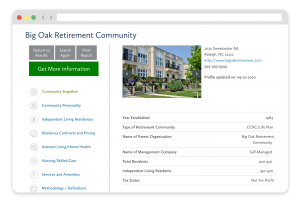One of the biggest obstacles in choosing a life plan community (more traditionally known as a continuing care retirement community or CCRC) is affordability. Or, as we like to say here at myLifeSite: Is it a good financial fit?
For many prospective residents of a life plan community, the question may not necessarily be whether they can “afford” it or not. The question is usually more about the extent to which one can afford it; i.e.: What will be the ultimate impact on my estate? How much may be left over for kids, grandkids, or charity? What about if I live longer or need more care than on average?
In this post, we’ll provide a roadmap you can use or share with your financial professional to help evaluate these types of questions.
Lifetime affordability
The first thing to keep in mind when assessing the affordability of a life plan community is that, unlike a simple cost comparison tool, the timeframe for your financial projections should be for the remainder of your life. Since life plan communities usually provide services across the continuum of care — from independent living, to assisted living, to skilled nursing care — you should not need to leave the community if your care needs change later in life. Indeed, having access to all of the services you may need in the future is one of the big appeals of a life plan community; a plan for life.
Additionally, since residents of life plan communities live longer, on average, than the general population, it’s probably wise in your financial projections to add 2-3 years to whatever the life expectancy table shows. If you want to be even more conservative, or you have a family history of people living a long life, you can add a few more years.
>> Related: Senior Living Affordability: A Top Priority For Choosing a Retirement Location
Type of CCRC residency contract
The next critical piece to preparing an accurate assessment of the affordability of a life plan community is understanding the type of residency contract(s) offered by the community. There are two key parts to this:
Entry fees
The majority of life plan communities require an entry fee, although there are more rental options becoming available. (As an aside, it is helpful to know that the monthly service fees at a rental life plan community will likely be substantially higher than the monthly service fees at an entry fee community, all other things being equal.)
If there is an entry fee, it will need to be factored in as a cash outlay in the first year of the financial projection. Typically, the proceeds of a home sale will go towards the entry fee for a new CCRC resident. If there isn’t a home to be sold, then the amount of the entry fee will need to be pulled from other assets or accounts. Understanding the potential tax implications of such asset liquidation or account withdrawal is important to this decision.
The other aspect of the entry fee that needs to be taken into account is whether it is refundable. If, for example, the entry fee is 80% refundable and this money would go to your heirs, this should be taken into account. Learn more about refundable entry fees.
Monthly service fees
A long-term assessment of affordability at a life plan community will be largely influenced by your contract type and the resulting potential change in your monthly service fees if you later require assisted living or nursing care in the healthcare center. Factoring in the proper pricing adjustments, especially in the case of a couple, is necessary for accurate cost projections and comparisons.
With some life plan contracts, the resident will pay the full cost of care as it is needed. With other contracts, the care services are included in the monthly service fee. Learn more about how monthly fees adjust based on the type of residency contract.
Additional monthly expenses
After accounting for the timeframe, potential entry fees, and the monthly service fee model, it’s also necessary to include additional monthly expenses a CCRC resident may incur.
Although the monthly service fee covers many of the services you will utilize on a day-to-day basis, you’ll still have other expenses to account for in your projections, especially while still living in independent living. Examples may include Medicare and other insurance premiums, occasional dining out or buying groceries, out-of-pocket medical expenses, subscriptions, and more. You should also take time to learn exactly what services are included in the monthly fee and what costs extra.
Lastly, if the life plan community offers a lifecare contract, there will likely be an additional cost for meals that will be added to your monthly service fee if you move into the healthcare center. The reason is that even though your monthly service fee may already cover any needed care services received in the healthcare center, it may not include all three meals you would be provided each day, should you require care. This can add a few hundred dollars per month to a resident’s monthly fee while they are living in the healthcare center.
>> Related: Crunch the Numbers: Aging at Home vs. Moving to a CCRC
Simplifying a complex calculation on CCRC affordability
Trying to calculate how much a life plan community will cost over a prospective resident’s lifetime is a complex equation with numerous variables to consider. The factors will vary based on the community, contract type, independent living residence options, lifespan, and more. It’s easy to see why many prospects get overwhelmed when trying to project their potential costs.
myLifeSite offers a variety of solutions to simplify the CCRC affordability calculation. If you are a representative of a life plan community or senior living organization and would like access to tools that can give your prospective residents more financial clarity, contact us or visit our industry solutions page for more details.

FREE Detailed Profile Reports on CCRCs/Life Plan Communities
Search Communities







